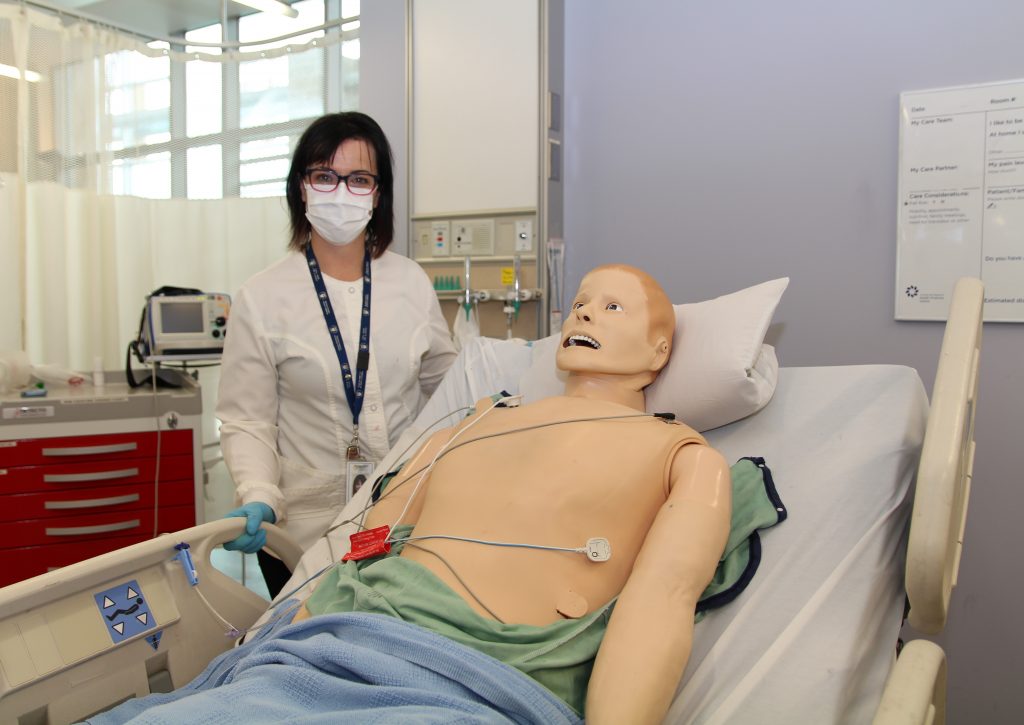Heart Month Profile: Simon, Ibn Sina Simulation Lab / Interprofessional Education Department
by Marcello Bernardo
 Meet Simon, the high-fidelity mannequin in the Ibn Sina Simulation Lab / Interprofessional Education department (pictured here with Leanne Baird, Simulation Technologist at TBRHSC).
Meet Simon, the high-fidelity mannequin in the Ibn Sina Simulation Lab / Interprofessional Education department (pictured here with Leanne Baird, Simulation Technologist at TBRHSC).February was Heart Month, which gave us an opportunity to highlight staff and departments at Thunder Bay Regional Health Sciences Centre (TBRHSC) who play a vital role in cardiovascular care. Today, we’re featuring one more unique member of the team. Meet Simon, the high-fidelity mannequin in the Ibn Sina Simulation Lab / Interprofessional Education department (pictured here with Leanne Baird, Simulation Technologist at TBRHSC).
What is your role?
My name is Simon and I am a high-fidelity mannequin. I allow health care professionals at TBRHSC to practice many lifesaving skills, including Advanced Cardiac Life Support (ACLS). Nurses, physicians, residents, medical students, and Registered Respiratory Therapists all have a role in ACLS.
What does it take to be a high-fidelity mannequin in the Ibn Sina Simulation Lab / Interprofessional Education department?
Well, I will not sugar coat this. My job is tough. Yes, I do get to lay in bed but when I am working, it is grueling. I don’t get paid, but I signed up for this job knowing that my number one priority is to make sure that everyone I work with develops stronger skills.
What is unique about your role?
Unlike a real person, I am a willing participant for repeated heart attacks. I allow people to practice their chest compressions and can even show them on my monitor just how effective they are. I can easily switch between 32 different heart rhythms and when I am hooked up to the heart monitor, my heart rhythm and rate are demonstrated on real hospital equipment. I can be defibrillated (shocked) and have cardioversion and pacing performed. I can also simulate 16 different heart sounds from any area of my high-tech, artificial heart. I have lost count of the number of times that I have received a shock but would guess it is in the thousands! Some of my other features include having a realistic airway which allows for the insertion of a breathing tube. I breathe, have pulses, have seizures, and have eyes that can react to light. I can also bleed, sweat and cry. With a little bit of help (usually from Leanne), I can speak too!
What inspired you to work in the Ibn Sina Simulation Lab / Interprofessional Education Department and cardiac care?
As a high-fidelity mannequin, I am specifically designed for this type of role. I didn’t necessarily decide to work in the Ibn Sina Simulation Lab /Interprofessional Education department but they chose me. I am proud to be one of the mannequins and task trainers in the department.
How does your role impact patient care?
When simulation participants come to me in the Ibn Sina Simulation Lab, or I go visit them in their departments, the goal is always to learn. It is always stressed that all participants are intelligent, capable and care about doing their best with the desire to improve. After repeated practice with me, all participants become more competent in their abilities. Participants can practice on me and make consequence-free mistakes in a safe environment, so when it’s time to take care of real patients, they’ve already learned the best way to provide care. This ultimately leads to better patient outcomes.
On the concept of practice what you preach, do you have any personal tips on how to stay heart healthy?
My only advice is to listen to the health care professionals, stay active and eat well.
Any final thoughts?
Staff at TBRHSC are well prepared to care for patients and families because they have trained repeatedly on me. To find out more about simulation or to inquire about booking a training session, staff can contact the Interprofessional Education Department.